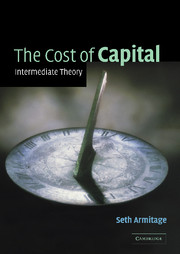Book contents
- Frontmatter
- Contents
- List of figures
- List of tables
- Preface
- Part I Expected Returns on Financial Assets
- Part II A Project's Cost of Capital
- 6 Project valuation
- 7 Corporation tax, leverage and the weighted average cost of capital
- 8 Personal tax and the cost of equity: the old and the new views
- 9 Personal tax, leverage and multiple tax rates
- 10 Inflation and risk premiums
- 11 The international dimension
- Part III Estimating the Cost of Capital
- References
- Index
7 - Corporation tax, leverage and the weighted average cost of capital
Published online by Cambridge University Press: 05 June 2012
- Frontmatter
- Contents
- List of figures
- List of tables
- Preface
- Part I Expected Returns on Financial Assets
- Part II A Project's Cost of Capital
- 6 Project valuation
- 7 Corporation tax, leverage and the weighted average cost of capital
- 8 Personal tax and the cost of equity: the old and the new views
- 9 Personal tax, leverage and multiple tax rates
- 10 Inflation and risk premiums
- 11 The international dimension
- Part III Estimating the Cost of Capital
- References
- Index
Summary
Corporate and personal taxes affect a project's value because they affect the cash flows received by the providers of capital. It is conventional for some of the impact of taxes on cash flows to be reflected in the discount rate rather than in the cash flows to be discounted, as discussed in the previous chapter. In principle, it might be possible to prepare a cash flow forecast with bottom-line cash flows that were net of all the taxes expected to be paid. The project's cost of capital would then be a required rate net of all tax. In practice, cash flows and the cost of capital are never expressed net of all the taxes expected to be paid.
The current chapter is concerned with the combined effect of leverage and corporation tax on the cost of capital, ignoring personal tax. The reason why leverage has an impact is that it affects the amounts of corporation tax to be paid, because interest payments do not attract corporation tax. Before proceeding with this topic, we note some preliminary points about the effects of taxes on the cost of capital.
Preliminaries
Rates of return and levels of tax
One way of using the cost of capital in project appraisal is to compare it with the project's internal rate of return. There must, therefore, be consistency with respect to tax in the measurement of the internal rate of return and of the cost of capital. To clarify how taxes affect the rate of return on a project, consider a simple example.
- Type
- Chapter
- Information
- The Cost of CapitalIntermediate Theory, pp. 153 - 180Publisher: Cambridge University PressPrint publication year: 2005



